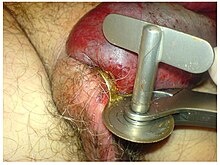Auto-erotic accident
An autoerotic accident is a process in which a person inadvertently inflicts significant injury on himself during masturbation or other autoerotic activity. In the case of a fatal injury, the term autoerotic suicide is used .
Occurrence
Mostly, autoerotic activities lead to minor or more severe injuries that are not statistically recorded. Mostly men are affected. Since many patients withhold the actual course of the accident from the doctor out of shame, exact figures on the frequency are not available. Even in the case of fatal autoerotic accidents, these are often not recognized and investigated as such. It is estimated that at least 100 people die from it in Germany every year. Other estimates suggest one to two fatal accidents associated with masturbation per million people per year.
species


Auto-erotic accidents can be roughly divided into the following categories:
- Penis injuries caused by masturbation with the help of objects
- Insertion and disappearance of objects in body orifices, such as " urethral stimulation " or foreign bodies in the anus and rectum or foreign bodies in the vagina
- Accidents during (auto) erotic activity that include pleasure pain , erotic electrical stimulation , bondage or erotic asphyxiation ( strangulation ).
Practices of self- gratification , which in various ways limit or interrupt the oxygen supply to the brain and thereby intensify sexual sensation ( asphyxiophilia or hypoxyphilia ), constitute a considerable risk potential ; likewise the application of mechanical, chemical (e.g. capsaicin ) and also electrical sources of stimulation to erogenous zones and genitals , but also the most varied forms of strangulation or constriction of body parts and genitals. With many of these techniques, serious to fatal injuries occur more frequently during masturbation, even despite previous safety measures.
exploration
As early as 1900, individual strange finding situations in cases of death with an apparently autoerotic background were described in articles, but it was not until the 1960s that autoerotic accidents were systematically researched and dissertations and journal articles were published on this. A dissertation on vacuum cleaner accidents , written in 1978, attracted particular public attention .
The mode of action of hypoxyphilia is not exactly understood. Working hypothesis is: a lack of oxygen triggers a narcotic and at the same time euphoric effect in the brain. Simultaneous orgasm could trigger a dopamine surge that makes the orgasm more intense. This combination is said to create a high that resembles a drug trip.
Forensic problems
Even without attempts to cover up survivors, it is difficult to distinguish a fatal autoerotic accident from a general accident, a sexual offense or a suicide . Evidence of an autoerotic background in a corpse can be, for example: the exposure of genitals, the presence of gags , laces, shackles of body parts, electrical cables attached to the body, mirrors set up for self-observation, pornographic or nudes at the place of discovery, in the case of male victims also women's clothing in the immediate vicinity or in laid-out form.
Legal problems
Occasionally, when sufferers try to cover up the cause of their injuries, there are problems with health insurance . By reconstructing the course of events by forensic experts, it must then be clarified whether it is a domestic accident or an operation that the insured person has carried out on his body.
An autoerotic accident resulting in death does not count as an accident in Germany in the sense of the general accident insurance conditions and therefore does not result in an accident insurance obligation .
literature
- A. Sauvageau and S. Racette: Autoerotic deaths in the literature from 1954 to 2004: a review. In: J Forensic Sci 51, 2006, pp. 140-146. PMID 16423241 .
- Werner Kammer, Clinic for penile injuries taking into account the masturbatory aspect , dissertation at the University of Munich , 1971 DNB 730567125 .
- Hans Krings, Autoerotic Accidents , Dissertation at the University of Cologne , 1973 DNB 751098361 .
- Sandra Kuhn: Autoerotic deaths in Hamburg and Munich 1983–2002. Dissertation, Hamburg, 2009
- Peter Schwab, Deaths from strangulation and rebreathing in autoerotic activity , dissertation at the University of Düsseldorf , 1975
- Werner Naeve, Sigrid Wittram, Fatal autoerotic accidents. The insurance medical examination and assessment of deaths in “autoerotic finds situation” , Versicherungswirtschaft, Karlsruhe 1977, DNB 780057570 (based on the dissertation of S. Wittram at the University of Hamburg 1975).
- Theimuras Michael Alschibaja: Penis injuries during masturbation with vacuum cleaners . Dissertation at the Technical University of Munich 1978 DNB 810005093 .
- Atlas of Forensic Medicine. edited by Waldemar Weimann , Otto Prokop and Georg Radam, 2nd edition, Karger, Basel 1987, ISBN 3-8055-4144-9 , pp. 581–605.
- Numerous articles in the journal Archiv für Kriminologie (volume / page): 125/164, 129/16/71, 131/166, 133/142, 135/16, 136/22, 137/17, 142/133, 148 / 106, 163/25, 171/19, 188/20, 192/17, 199/27, 200/65, 207/148, 212/176 etc.
Web links
- Autoerotic accident in forensic medicine at the University of Leipzig ( Memento from December 11, 2007 in the Internet Archive )
- Sandra Kuhn: Autoerotic deaths in Hamburg and Munich 1983-2002 , dissertation, Hamburg, 2009
Individual evidence
- ↑ See Klaus M. Beier (Ed.), Sexualmedizin. Basics and Practice , 2nd edition 2005, p. 489
- ↑ GM Pinggera et al .: Penile strangulation in a patient with Parkinson's disease: a case report. In: Cases Journal 2, 2009,9379 doi : 10.1186 / 1757-1626-2-9379
- ↑ TM Alschibaja: Penis injuries during masturbation with vacuum cleaners (PDF file; 993 kB)
- ↑ J. Falk, T. Riepert, M. Rothschild: Traumatic partial amputation of the penis - to reconstruct an accident . In: Versicherungsmedizin 57.2005,1, pp. 17-19. PMID 15759810
- ^ LG Heidelberg , judgment of December 14, 1995, Az. 1 O 187/95